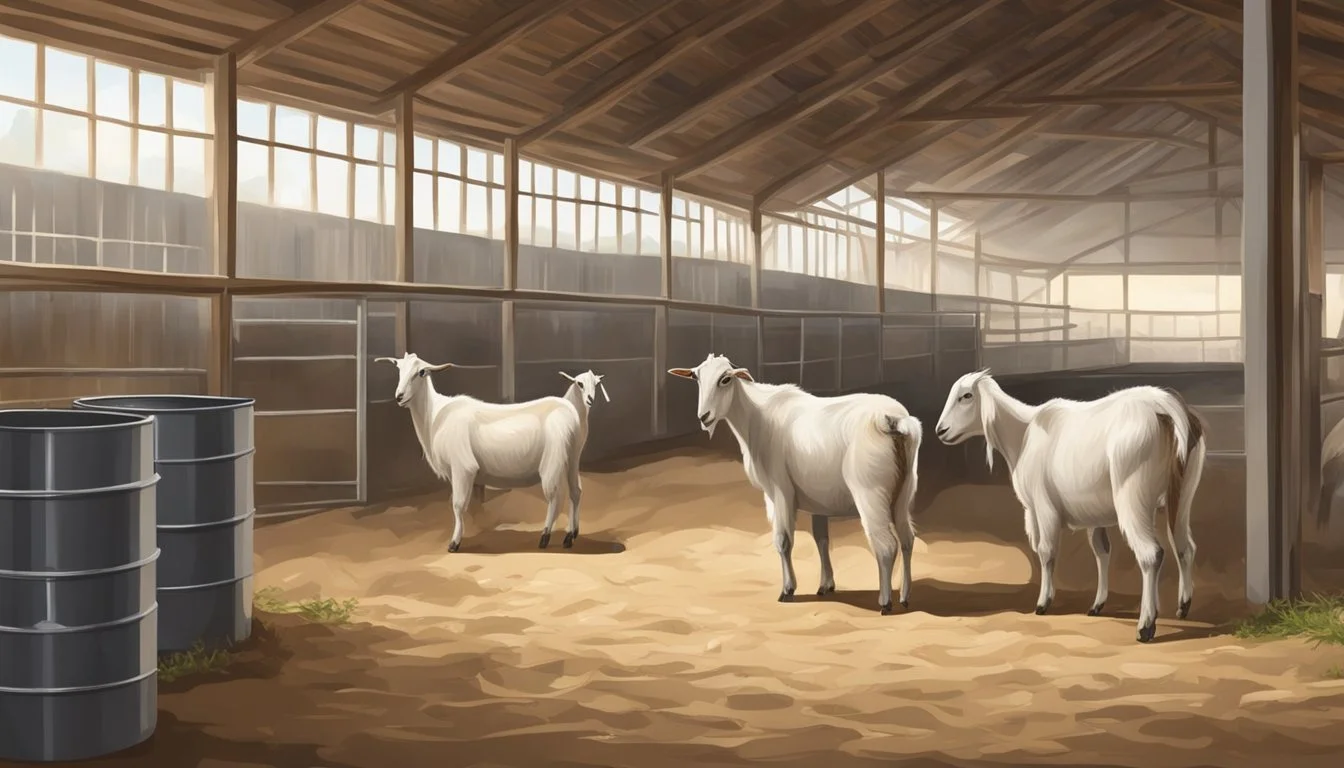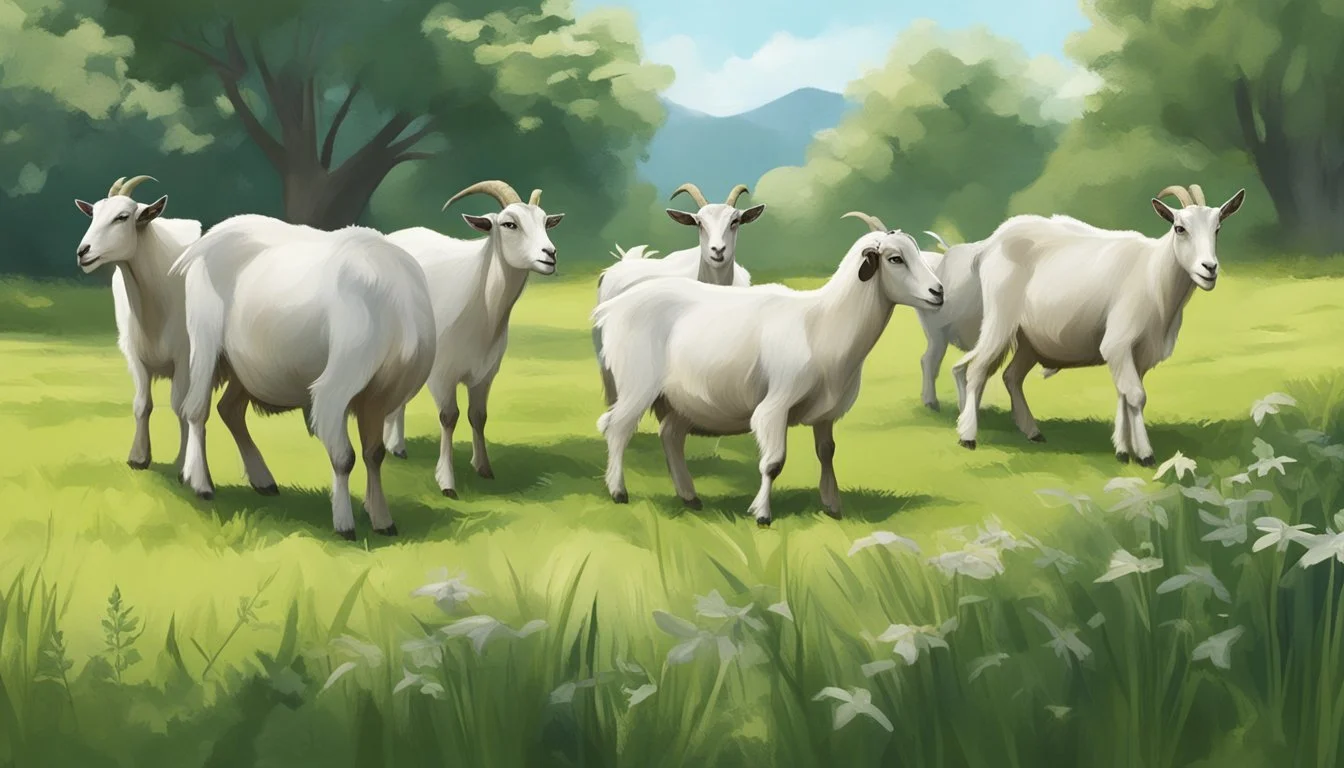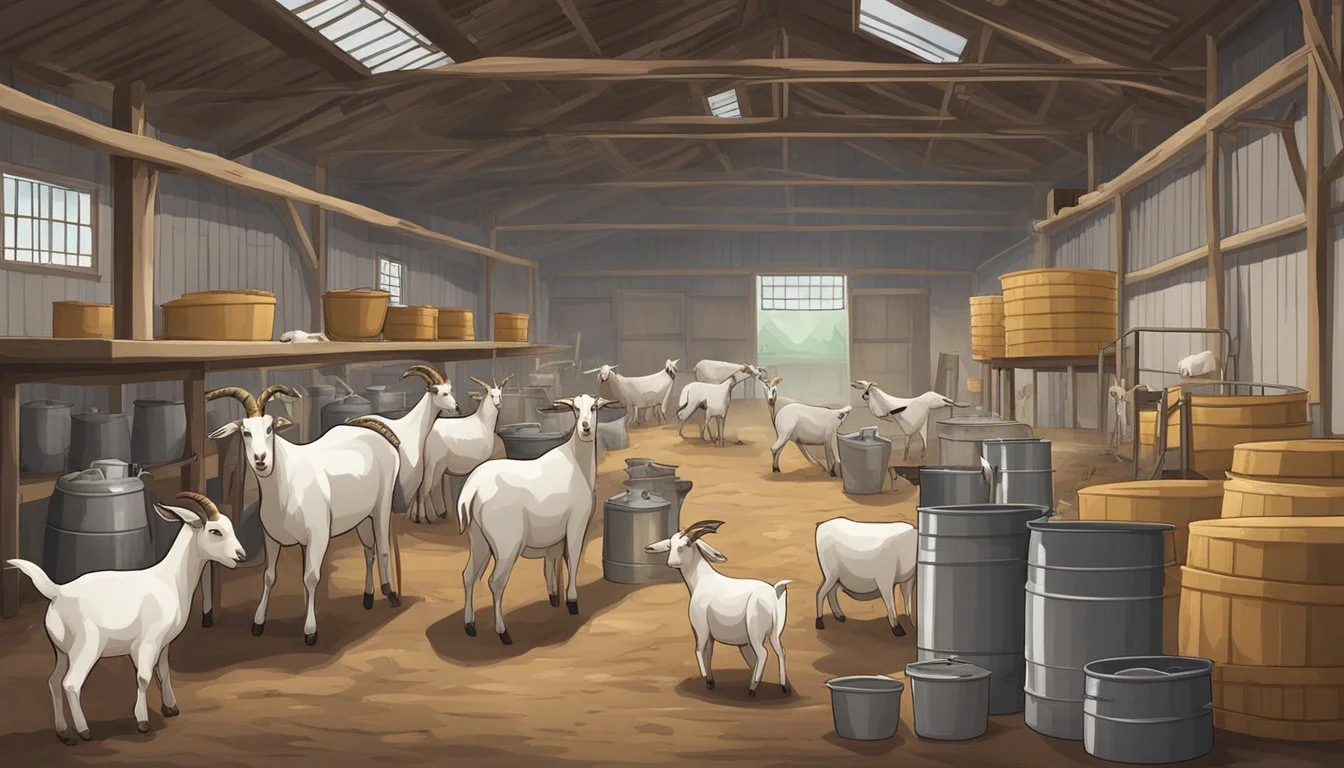What Are the Common Reasons for Decreased Milk Production in Dairy Goats
Uncovering the Causes
Dairy goats are a valuable source of milk production internationally. Variations in milk yield can significantly impact both small-scale and commercial farmers, making the understanding of factors influencing production levels critically important. Decreased milk output in dairy goats can be attributed to a variety of reasons, ranging from the animal's health status to environmental conditions.
Factors such as stress, health issues like mastitis, and nutritional deficiencies are well-known to affect a goat's ability to produce milk optimally. Stress disrupts the physiological balance in goats, leading to reduced milk secretion. Health challenges, particularly mastitis—an inflammation of the mammary gland—can severely diminish milk yield. Moreover, proper nutrition is fundamental for maintaining steady milk production, and any deficiency in a goat's diet can result in a noticeable drop in output.
The age of the goat and the season of the year also play roles in the quantity of milk produced. Production naturally declines as goats age, with a more pronounced decrease after about 10 years. Seasonal changes, with lower production typically seen during winter months, reflect the influence of environmental factors. By identifying and addressing these common issues, dairy farmers can take proactive steps to optimize milk production within their herds.
Biology of Milk Production
Understanding the biology of milk production is essential for addressing challenges related to lactation in dairy goats. The process encompasses an intricate network of anatomical structures, physiological responses, and hormonal controls that work in harmony to produce milk.
Anatomy of the Mammary Gland
The mammary gland is a key component in milk production, consisting of an arrangement of alveoli, ducts, and blood vessels. Each alveolus is surrounded by myoepithelial cells that, upon hormonal stimulation, contract to eject milk into the ductal system. The efficient function of these structures is crucial for optimal milk yield.
Physiological Factors
Various physiological factors influence milk production. Hydration is one core element; sufficient water intake is paramount for maintaining milk volume. Additionally, a dairy goat's age plays a role, as does the genetic makeup, which can predispose them to higher or lower milk yields. Gestation and subsequent freshening (giving birth and beginning of milk production), as well as the dry period (rest between lactations), impact milk production volumes as well.
Stages of Lactation
Lactation proceeds through several stages, each critical for milk production. Initially, colostrum is produced, providing essential nutrients and antibodies to newborns. Thereafter, the quantity and composition of the milk stabilize during the peak lactation phase. As the lactation advances, a gradual decrease in production is typical due to the natural stress and involution of the mammary gland.
Hormones and Regulation
Hormonal regulation is the cornerstone of milk synthesis and secretion. Prolactin, oxytocin, estrogen, and progesterone coordinate to trigger and sustain milk production. Prolactin stimulates milk synthesis, while oxytocin is responsible for the "let-down" reflex. Alterations in the balance of these hormones can significantly affect milk output in dairy goats.
Nutritional Requirements
Nutrition profoundly impacts milk production in dairy goats. Balancing their diet in terms of protein, vitamins, minerals, types of feed, and water is essential for their lactating efficiency and overall health.
Importance of Protein
Protein plays a critical role in milk production as it is a major component in milk's solid content. Dairy goats require sufficient protein to sustain high levels of milk production. Low protein intake can lead to decreased milk yield. Feeds with a high protein content, such as soybean meal, are often included in a dairy goat's diet to meet these nutritional requirements.
Vitamins and Minerals
Dairy goats need a well-balanced intake of vitamins and minerals for optimal milk production. Essential minerals like calcium and phosphorus are vital for milk synthesis. Inadequate supplies may not only reduce milk output but also affect the health of the goats. For instance, lack of calcium can lead to hypocalcemia, characterized by muscle twitching and nervous behavior, detrimental to both milk production and the goat's well-being.
Effect of Forages and Concentrates
The foundational diet for dairy goats usually consists of forages such as hay or pasture, which should be high quality to aid in milk production. In addition, concentrates like grains provide energy that forages alone may lack. However, the diet needs to be carefully balanced, as overreliance on concentrates can lead to digestive issues, while inadequate forage can compromise milk quantity and quality.
Hydration for Milk Production
Hydration is essential, as milk consists mostly of water. Dairy goats should have constant access to clean water to maintain health and high milk production. Dehydration in dairy goats can quickly lead to a decline in milk output, so adequate water intake is just as crucial as solid feeding practices.
Environmental and Management Factors
Environmental and management factors play a critical role in the productivity and welfare of dairy goats. These factors can influence milk production through their impact on the animals' comfort, stress levels, and overall health.
Housing and Comfort
Proper housing is essential for maintaining optimal milk production in dairy goats. Goats need a clean, dry, and well-ventilated living space to prevent diseases and stress. Bedding should be comfortable and regularly refreshed to ensure a restful environment. Temperature control is important as well, as extreme heat or cold can reduce productivity and affect the goats' health.
Herd Management Practices
Effective herd management is crucial for the success of a dairy herd. This includes routine health checks, vaccinations, and parasite control to prevent illness and the spread of disease within the herd. Nutritional management tailored to the specific needs of milking goats, including access to clean water and high-quality feed, directly impacts milk yield and animal welfare.
Milking Routines and Techniques
Consistent and gentle milking routines can influence the quantity and quality of milk produced. It's important to establish a regular milking schedule as irregular milking can cause stress to the goats and lead to decreased milk production. Using proper and clean milking techniques helps to maintain the health of the udder and the hygienic quality of the milk. Advanced milking technology, when used correctly, can also enhance milking efficiency and ensure the well-being of the animals.
Health and Diseases
A variety of health issues, including specific diseases and inflammatory conditions, can lead to decreased milk production in dairy goats. These complications often require a veterinarian's diagnosis and intervention to manage the lactation impact.
Common Diseases Affecting Lactation
Diseases can significantly impede milk yield in dairy goats. Mastitis, an inflammation of the mammary gland, is typically caused by bacterial infection and can reduce milk output. The lactation process may also be affected by metabolic disorders such as ketosis, especially during peak milk production periods when energy demands are high. Another concern is foot rot, which if chronic can lead to decreased feeding and subsequently lower milk production.
Inflammation and Somatic Cell Count
Inflammation within the udder, often a response to infection, increases the somatic cell count (SCC), which serves as an indicator of milk quality and udder health. Higher SCCs often correlate with mastitis and can be a sign of other health issues affecting milk production. Monitoring SCCs is a critical component of Dairy Herd Improvement programs aimed at maximizing the health and productivity of dairy goats.
Preventative Health Measures
Preventative measures are key in maintaining the overall health and thus milk production levels of dairy goats. A thorough vaccination protocol, regular health check-ups by a veterinarian, and adherence to a nutritionally balanced diet can help prevent the onset of diseases that affect lactation. Additionally, consistent hygienic practices in milking can aid in reducing the risk of inflaming the udder, aiding in keeping milk production steady.
Breeding and Genetics
The intersection of breeding and genetics plays a critical role in the milk production capacities of dairy goats. Understanding how these factors contribute can significantly affect the profitability and effectiveness of a dairy goat breeding plan.
Role of Genetics in Milk Production
Genetics is the backbone of milk production in dairy goats. Specific genes influence the quantity and quality of milk by controlling traits such as milk yield, fat content, protein levels, and lactation length. A genetic evaluation using test-day models can provide in-depth insights into these production traits. For example, analyzing test-day data allows for a more precise understanding of the genetic contributions to daily milk yield and its components.
Breeding Programs and Selection
Breeding programs are essential for enhancing these genetic factors. By selecting individuals with superior genetic makeup for milk production, breeders can improve the overall productivity of their herds. Selection processes often involve identifying goats with desirable traits and using them in goat breeding strategies to ensure the propagation of those traits in future generations, leading to improved profitability.
Importance of Diverse Genetic Lines
Diversification of genetic lines is critical for the long-term sustainability and robustness of dairy goat herds. Introducing diverse genetic lines can help mitigate the risks of inbreeding depression and increase herd resistance to disease. It is also beneficial for broadening the genetic base, which can lead to the discovery of new alleles that positively impact milk production and other valuable traits for dairy breeds.
Lifecycle and Reproduction
In dairy goats, the interplay between lifecycle and reproductive events plays a critical role in determining milk yield and longevity. Understanding how age, gestational phases, and breeding strategies affect lactation is vital for optimizing milk production.
The Impact of Age and Stage
Milk production in dairy goats is influenced by the age and stage of the animal. Particularly, the first lactation, which occurs after the goat freshens for the first time, is often lower in milk yield compared to subsequent lactations. This yield typically increases until it peaks around the third or fourth lactation before it begins to decline as the goat advances in age. Younger goats need special attention as they transition from the weaning stage into their productive life to ensure they reach their potential for milk production.
Managing Gestation for Optimal Production
Gestation plays a crucial part in a doe's milk production cycle. It lasts approximately 150 days, and the optimal milk production is usually observed after the doe has recovered from kidding and her body has adjusted to lactation demands. Careful management during this period is required to balance the health of the doe and her kids with the aim of achieving a high milk yield once she freshens. Producers must monitor nutrition, health, and comfort during gestation to achieve successful freshening and subsequent lactation.
Breeding Plans and Kidding
A well-conceived goat breeding plan is essential for managing milk production. It involves strategic decisions about when to breed does to optimize both the quality and quantity of milk. Timing of breeding affects not only milk yield but also the herd's adaptation to seasonal fluctuations in milk demand. The kidding interval should be carefully calculated to ensure a steady production of milk throughout the year. Furthermore, attention must be given to breeding practices that sustain the herd's longevity and ongoing productivity.
Industry and Market Factors
The dairy goat industry is shaped by a multitude of factors including production systems and market demands which directly impact milk production and profitability. Understanding these factors is crucial for stakeholders to make informed decisions and adapt for future sustainability.
Milk Production Systems
Milk production systems play a pivotal role in the volume and efficiency of dairy goat operations. Intensive systems that leverage technological advancements and optimized feeding schedules can enhance milk yield. Conversely, extensive systems, which rely on natural foraging, may result in reduced outputs due to less controlled diet and environmental conditions. Production system choices affect not only the quantity but also the quality of milk produced.
Milk Quality and Standards
Milk quality is paramount in the dairy industry. High standards must be met for goat milk to be deemed suitable for consumer use. Factors such as somatic cell count and bacterial content are heavily scrutinized. Poor milk quality can lead to a cull in production or even rejection from processing facilities, impacting profitability negatively.
Demand for Goat Milk and Products
The demand for goat milk and products is influenced by consumer preferences and health trends. While some regions exhibit a strong market for goat milk, often due to its perceived health benefits, others may show lukewarm interest. Variance in demand ultimately affects the volume of milk needed from producers, which in turn influences milk production strategies.
Sustainability and Carbon Footprint
Sustainability concerns, including the carbon footprint of dairy goat farming, are increasingly important to consumers and regulators. Practices that reduce greenhouse gas emissions and promote environmental health are not just ethical choices but can also be leveraged as marketing tools to meet the demands of a conscientious consumer base. Furthermore, sustainable practices often align with improved animal welfare, which can positively affect milk production and milk quality.
Socio-Economic Influences
Socio-economic factors play a significant role in the production of dairy goats, influencing everything from cultural consumption patterns to the economic strategies of producers.
Cultural Preferences and Nutrition
In regions like France, where cheese is an integral part of national cuisine, there is a strong preference for goat cheese. This cultural inclination affects the demand for goat milk, as certain cheeses are prized for their distinct flavors and associated with traditional French gastronomy. The nutritional value of goat milk, often compared favorably to cow milk and sheep milk, also plays a role in consumer preferences and impacts production levels.
Goat Populations Across Europe
Europe exhibits diverse dairy breeds and goat populations, with variations in dairy production across the continent. While some countries may have robust numbers of dairy goats, others might experience a decline due to economic pressures or shifts in agricultural priorities. For instance, fluctuations in the goat population can directly affect milk supply and the availability of goat cheese.
Economic Viability and Producer Strategies
Dairy producers focus on the profitability of their operations, which can be influenced by market demand, the cost of feed, labor expenses, and even the economic policies of their respective countries. Effective strategies may include selective breeding for higher milk yield or quality, shifts toward or away from goat milk production based on market trends, and adjusting practices to meet the demand for artisanal cheese. In Europe, the economic success of dairy goat farming can hinge on how well producers adapt to these socio-economic influences.







